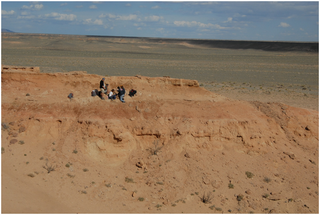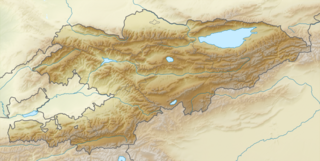Eobaataridae is a family of fossil mammal within the order Multituberculata. Remains are known from the Lower Cretaceous of Europe and Asia. These herbivores thus lived during the Mesozoic era, also known as the "age of the dinosaurs". They were among the most derived representatives of the informal suborder "Plagiaulacida".

The Nemegt Formation is a geological formation in the Gobi Desert of Mongolia, dating to the Late Cretaceous. The formation consists of river channel sediments and contains fossils of fish, turtles, crocodilians, and a diverse fauna of dinosaurs, including birds.

The Echkar Formation is a geological formation comprising sandstones and claystones in the Agadez Region of Niger, central Africa.

The Bostobe Formation is a geological formation in Qaraghandy & Qyzylorda, Kazakhastan whose strata date back to the Late Cretaceous.

Mamenchisauridae is a family of sauropod dinosaurs known from the Jurassic and Early Cretaceous of Asia and Africa.

The Bissekty Formation is a geologic formation and Lagerstätte which crops out in the Kyzyl Kum desert of Uzbekistan, and dates to the Late Cretaceous Period. Laid down in the mid to late Turonian, it is dated to about 92 to 90 Ma.

The Balabansai Formation is a geological formation in Kazakhstan, Kyrgyzstan and Uzbekistan whose strata date back to the Bathonian and Callovian stages of the Middle Jurassic. Dinosaur remains are among the fossils that have been recovered from the formation. The lithology primarily consists of variegated sandstones, siltstones, claystones, and rare gravels and marls. Many taxa have been found in the formation, including amphibians and mammals

The Andaikhudag Formation, in older literature referred to as Unduruh Formation or Ondorukhaa Formation, is an Early Cretaceous geologic formation in Mongolia. Dinosaur remains diagnostic to the genus level are among the fossils that have been recovered from the formation.

The Ialovachsk or Yalovach Formation is a Santonian geologic formation in Kyrgyzstan, Tajikistan and Uzbekistan. Fossil dinosaur eggs have been reported from the formation.

Kileskus is a genus of tyrannosauroid dinosaur known from partial remains found in Middle Jurassic Itat Formation of Sharypovsky District, Krasnoyarsk Krai (Russia). Fossils recovered include the holotype maxilla, a premaxilla, a surangular, and a few bones from the hand and foot. Additional remains referred to the species include cervical and caudal vertebrae, as well as a fibula. The skull bones are similar to those of Proceratosaurus. The type species is K. aristotocus. Kileskus was named in 2010 by Averianov and colleagues. Its size has been estimated at 5.2 meters in length and 700 kg in weight.

The Itat Formation is a geologic formation in western Siberia. It was deposited in the Bajocian to Bathonian ages of the Middle Jurassic. Dinosaur remains are among the fossils that have been recovered from the formation, including the proceratosaurid Kileskus, as well as fish, amphibians, mammals and many other vertebrates. The formation is noted for bearing significant coal reserves, with large open pit coal mines extracting lignite from the unit currently in operation.

The Khodzhakul Formation is a Cenomanian aged geologic formation in Uzbekistan. Dinosaur remains are among the fossils that have been recovered from the formation. As well as those of Mammals. It is part of the same stratigraphic succession as the overlying Bissekty Formation.
Sineleutherus is an extinct genus of euharamiyids which existed in Asia during the Jurassic period. The type species is Sineleutherus uyguricus, which was described by Thomas Martin, Alexander O. Averianov and Hans-Ulrich Pfretzschner in 2010; it lived in what is now China during the late Jurassic Qigu Formation. A second species, Sineleutherus issedonicus, was described by A. O. Averianov, A. V. Lopatin and S. A. Krasnolutskii in 2011. It lived in what is now Sharypovsky District during the middle Jurassic ; its fossils were collected from the upper part of the Itat Formation. However, this is now believed to represent several euharamiyid taxa not closey related to Sineleutherus.

The Ilek Formation is a Lower Cretaceous geologic formation in Western Siberia. Many different fossils have been recovered from the formation. It overlies the Late Jurassic Tyazhin Formation and underlies the Albian Kiya Formation.

The Zhirkindek Formation is a Late Cretaceous geologic formation in Kazakhstan. The primary lithology is sand with interbeds of clay and silt, and represents a coastal to coastal marine environment. The formation has produced numerous fossils, including Lindholmemydid and Trionychid cryptodires, indeterminate remains of dinosaurs and an indeterminate species of pterosaur Azhdarcho.
Tengrisaurus is a genus of lithostrotian sauropod, from the Early Cretaceous (Barremian-Aptian) Murtoi Formation, Russia. It was described in 2017 by Averianov & Skutschas. The type species is T. starkovi. New remains were described in 2021 by Averianov, Sizov & Skutschas.

The Moskvoretskaya Formation is a Middle Jurassic geologic formation in the European part of Russia. It consists of continental claystones, siltstones and sandstones deposited in karstified segments of underlying Middle Carboniferous limestone, that would have formed underground aquifers.

The Batylykh Formation is a geological formation in Yakutia, Russia. It is of an uncertain Early Cretaceous age, probably dating between the Berriasian and the Barremian. It is the oldest unit of the 1,500 metres (4,900 ft) thick Sangar Series within the Vilyuy syneclise. The mudstones, sandstones and shales of the formation were deposited in a fluvial to lacustrine environment.

Mesochelydia is a clade within Pantestudines, more inclusive than Perichelydia, but less than Testudinata. The clade is known from the Early Jurassic to the Present. The ancestral condition for Mesochelydia is thought to be aquatic, as opposed to terrestrial for Testudinata. They are distinguished from more basal testudinatans by the presence of the following characters: strap like pectoral girdle, supramarginals absent, reduced posterior entoplastral process, eleven pairs of peripherals, elongate processus interfenestralis, paired basioccipital tubercles, fully formed cavum tympani and antrum postoticum, single vomer, confluent external nares, lacrimals and supratemporals absent.

Dzharatitanis is a genus of rebbachisaurid sauropod from the Bissekty Formation in Uzbekistan, dating to the Turonian stage of the Late Cretaceous. The genus contains a single species, Dzharatitanis kingi, named after Christopher King, who contributed to the Cretaceous geology of Asia. It is the first recorded rebbachisaurid from Asia and one of the youngest known rebbachisaurids. Its location may have resulted from the migration of rebbachisaurids from Europe during the early-mid Cretaceous. It is currently one of two known sauropods from the Bissekty Formation, alongside an indeterminate titanosaur.












